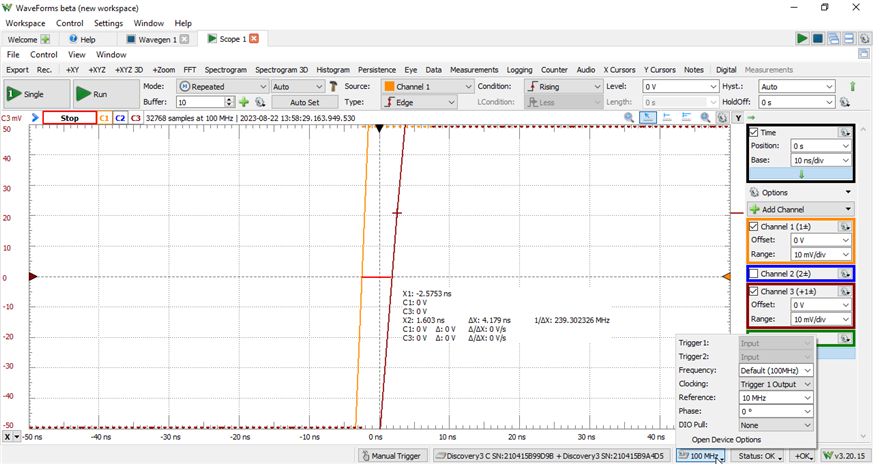Dual mode is a new feature recently unveiled in WaveForms, coinciding with the launch of Analog Discovery 3 . This addition enables users to connect two identical Mixed Signal Oscilloscopes, synchronizing their acquisitions to double the channel count of their acquisition system. This functionality isn't limited to just analog inputs; it extends seamlessly to analog outputs and digital inputs and outputs.
This feature also supports the Analog Discovery Pro 3000-Series, where users can connect two ADP3450s to create an impressive 8-channel scope system. The specific hardware connections required may vary, but for 3000 Series devices, a pair of short coax BNC cables will suffice for the connection.
In this post, we'll guide you through the setup of Dual mode using a pair of AD3 devices and configuring the system to account for clock delay. It's important to note that this feature is supported in version 3.20.1 of WaveForms, the latest release at the time of writing. Additionally, there are some enhancements available in the beta version of WaveForms, 3.20.15, which introduces degree units as a phase adjustment option, and this guide refers to these improvements. You can access beta versions through the Digilent Forum link.
GUIDE:
Hardware Setup
To utilize Dual mode effectively, you must connect the external trigger pins of the two devices. Connect T1 to T1 and T2 to T2. T1 carries a reference clock between the devices, ensuring they use the same clock source, while T2 passes the selected trigger source between them for synchronized acquisitions. Ground connections between the devices should also be established to minimize crosstalk. If you want to further reduce crosstalk, consider using a twisted wire pair for the T1 reference clock signal. Keeping cable lengths as short as possible ensures optimal performance.

Software Setup
Choose the host device, noting that the selection of the first device does not impact functionality.

Click on the "Select + Dual" option and choose the second identical device. Follow the instructions to connect Trigger 1 to Trigger 1, Trigger 2 to Trigger 2, and a ground pin between the two devices.

Open the Scope instrument.

You'll now see a secondary set of analog inputs from the additional device, labeled as Channel 3 (+1±) and Channel 4 (+2±) for a pair of Analog Discovery 3s. Below the screen, you'll find indicators displaying the selected devices, additional device settings, and device status, in that order.

Despite the synchronization of the two devices with a reference clock and trigger line, there might still be some phase differences due to propagation delay. Without adjustments, the same signal sent to both devices may exhibit a delay, typically around 2.5ns.

To rectify this, provide a phase adjustment through the "Phase" setting in the Device Options dropdown (the 100 MHz button) at the bottom of the window. This allows you to manually fine-tune the clock for the second device, aligning data sampling with respect to the clock edge. This adjustment compensates for the delay from one device to the other, ensuring data is sampled at approximately the same time.
For precise phase offset selection, employ a shared signal source to test the system. A square wave works well for this purpose, as it facilitates the comparison of rising edges.

Zoom in closely on the trigger point, enabling you to determine the nanoseconds of difference between the primary and secondary device as they cross the same threshold.

Adjust the Phase dropdown in the Device Options until both devices cross the threshold at nearly the same time, fine-tuning until you achieve your desired results.
Keep an eye on the reference clock option, as it allows you to modify the clock's frequency passed over the T1 trigger line. Different frequencies may perform better or worse based on your specific application.
Throughout this process, remember that channel ranges can be adjusted to spread the signal vertically across the plot, making it easier to identify zero crossings.
After some experimentation, you can significantly reduce phase offset. For instance, we managed to reduce it to 247.7 ps out of a 10 ns clock period (100 MHz clock) for our setup, which is ten times better than the default settings.
Conclusion
With these adjustments, you now have access to an oscilloscope system capable of simultaneously sampling four signals, greatly expanding your testing capabilities.
